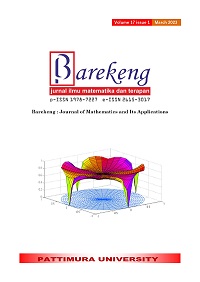A NUMERICAL STUDY OF SUBSTANCE SPREAD IN THE POLL FROM TWO POINT SOURCES
Abstract
Problems related to the purification of holding pool or reservoir become an interesting discussion in real events. In this paper, the author will modeling the distribution of the substance/purifier in a pool model with turbulent water flow using the diffusion-convection equation. The Dual Reciprocity Method is applied to the diffusion-convection equation whose derivation will be discussed in this paper. This method is chosen because the problem cannot be solved analytically, so it must be solved numerically. The Dual Reciprocity Method has good flexibility in problems of water infiltration, pollutant spread, and heat transfer. In this paper also discuss velocity profile of turbuelent flow from upcoming part of pool region. So before using DRM, will be used numerical solution of turbulent flow by k-epsilon turbulent model. In numerical calculations, two source points are selected whose positions are combined to see the most effective way to make the substance/purifier evenly distributed in the pool.
Downloads
References
N. Samec and L. Skerget, “Numerical modelling of pollutant dispersion in water systems,” Proc. Int. Conf. Dev. Appl. Comput. Tech. to Environ. Stud., vol. 25, pp. 45–54, 1998.
A. D. Polyanin, “Functional separable solutions of nonlinear convection–diffusion equations with variable coefficients,” Commun. Nonlinear Sci. Numer. Simul., vol. 73, pp. 379–390, 2019, doi: 10.1016/j.cnsns.2019.02.022.
V. F. Morales-Delgado, J. F. Gómez-Aguilar, and M. A. Taneco-Hernández, “Analytical solution of the time fractional diffusion equation and fractional convection-diffusion equation,” Rev. Mex. Fis., vol. 65, no. 1, pp. 82–88, 2019, doi: 10.31349/revmexfis.65.82.
F. Wang, C. M. Fan, C. Zhang, and J. Lin, “A localized space-time method of fundamental solutions for diffusion and convection-diffusion problems,” Adv. Appl. Math. Mech., vol. 12, no. 4, pp. 940–958, 2020, doi: 10.4208/aamm.OA-2019-0269.
X. Yue, F. Wang, Q. Hua, and X. Y. Qiu, “A novel space–time meshless method for nonhomogeneous convection–diffusion equations with variable coefficients,” Appl. Math. Lett., vol. 92, pp. 144–150, 2019, doi: 10.1016/j.aml.2019.01.018.
M. Zhang, W. Zhao, and P. Lin, “Lattice Boltzmann method for general convection-diffusion equations: MRT model and boundary schemes,” J. Comput. Phys., vol. 389, pp. 147–163, 2019, doi: 10.1016/j.jcp.2019.03.045.
J. H. He, “A simple approach to one-dimensional convection-diffusion equation and its fractional modification for E reaction arising in rotating disk electrodes,” J. Electroanal. Chem., vol. 854, pp. 147–163, 2019, doi: 10.1016/j.jelechem.2019.113565.
I. Boztosun and A. Charafi, “An analysis of the linear advection-diffusion equation using mesh-free and mesh-dependent methods,” Eng. Anal. Bound. Elem., vol. 26, no. 10, pp. 889–895, 2002, doi: 10.1016/S0955-7997(02)00053-X.
D. L. Clements and M. Lobo, “A BEM for time dependent infiltration from an irrigation channel,” Eng. Anal. Bound. Elem., vol. 34, no. 12, pp. 1100–1104, 2010, doi: 10.1016/j.enganabound.2010.06.013.
I. Solekhudin and K. C. Ang, “A Laplace transform DRBEM with a predictor-corrector scheme for time-dependent infiltration from periodic channels with root-water uptake,” Eng. Anal. Bound. Elem., vol. 50, pp. 141–147, 2015, doi: 10.1016/j.enganabound.2014.08.011.
I. Solekhudin, “A numerical method for time-dependent infiltration from periodic trapezoidal channels with different types of root-water uptake,” IAENG Int. J. Appl. Math., vol. 48, no. 1, pp. 84–89, 2018.
Munadi, I. Solekhudin, Sumardi, and A. Zulijanto, “A numerical study of steady infiltration from a single irrigation channel with an impermeable soil layer,” Eng. Lett., vol. 28, no. 3, pp. 1–8, 2020.
B. I. Ang and Y. W.T., “A Dual Reciprocity Element Approach for Axisymmetric Nonlinear Time-Dependent Heat Conducyion in a Nonhomogeneous Solid,” Eng. Anal. Bound. Elem., vol. 34, no. 8, pp. 697–706, 2010.
N. Y. Ashar, “An Application of Dual Reciprocity Boundary Element Method on Calculation of Pollutant Concentration Range in Twinned Path with Laminar Water Flow,” Universitas Gadjah Mada, 2020.
N. Y. Ashar and I. Solekhudin, “A numerical study of steady pollutant spread in water from a point source,” Eng. Lett., vol. 29, no. 3, pp. 840–848, 2021.
Copyright (c) 2023 Nurcahya Yulian Ashar, Susilo Hariyanto

This work is licensed under a Creative Commons Attribution-ShareAlike 4.0 International License.
Authors who publish with this Journal agree to the following terms:
- Author retain copyright and grant the journal right of first publication with the work simultaneously licensed under a creative commons attribution license that allow others to share the work within an acknowledgement of the work’s authorship and initial publication of this journal.
- Authors are able to enter into separate, additional contractual arrangement for the non-exclusive distribution of the journal’s published version of the work (e.g. acknowledgement of its initial publication in this journal).
- Authors are permitted and encouraged to post their work online (e.g. in institutional repositories or on their websites) prior to and during the submission process, as it can lead to productive exchanges, as well as earlier and greater citation of published works.






1.gif)



